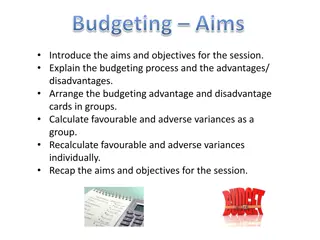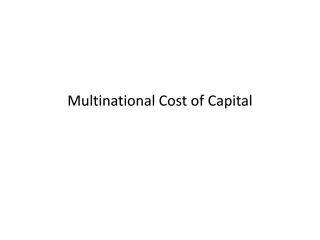Challenges in Multinational Capital Budgeting
Multinational Capital Budgeting extends the domestic analysis to evaluate foreign projects, focusing on cash flows, risk adjustments, and real option analysis. It involves complexities such as distinguishing parent cash flows from project cash flows, dealing with differing tax systems, political constraints, and estimating terminal values. Managers must navigate non-financial payments, varying national inflation rates, segmented capital markets, subsidies, and political risks when budgeting for foreign projects.
Download Presentation

Please find below an Image/Link to download the presentation.
The content on the website is provided AS IS for your information and personal use only. It may not be sold, licensed, or shared on other websites without obtaining consent from the author. Download presentation by click this link. If you encounter any issues during the download, it is possible that the publisher has removed the file from their server.
E N D
Presentation Transcript
Chapter 18 Multinational Capital Budgeting 1
Multinational Capital Budgeting Extension of the domestic capital budgeting analysis to evaluate a Greenfield foreign project Distinctions between the project viewpoint & the parent viewpoint when analyzing a potential foreign investment Adjusting the capital budgeting analysis of a foreign project for risk Introduction of the use of real option analysis as a complement to DCF analysis in the evaluation of potential international investments 2
Multinational Capital Budgeting Like domestic capital budgeting, this focuses on the cash inflows and outflows associated with prospective long-term investment projects Capital budgeting follows same framework as domestic budgeting Identify initial capital invested or put at risk Estimate cash inflows, including the terminal value or salvage value of the investment Identify appropriate discount rate for NPV calculation Determine the NPV and IRR 3
Complexities of Budgeting for a Foreign Project Several factors make budgeting for a foreign project more complex Parent cash flows must be distinguished from project Parent cash flows often depend on the form of financing, thus cannot clearly separate cash flows from financing this changes the meaning of NPV Additional cash flows from new investment may in part or in whole take away from another subsidiary; thus as a stand alone a project may provide cash flows but overall may add no value to the entire organization Parent must recognize remittances from foreign investment because of differing tax systems, legal and political constraints 4
Complexities of Budgeting for a Foreign Project Non-financial payments can generate cash flows to parent in the form of licensing fees, royalty payments, etc. relevant for parent s perspective Managers must anticipate differing rates of national inflation which can affect cash flows Use of segmented national capital markets may create opportunity for financial gains or additional costs Use of host government subsidies complicates capital structure and parent s ability to determine appropriate WACC Managers must evaluate political risk Terminal value is more difficult to estimate because potential purchasers have widely divergent views 5
Project versus Parent Valuation Most firms evaluate foreign projects from both parent and project viewpoints The parent s viewpoint analyzes investment s cash flows as operating cash flows instead of financing due to remittance of royalty or licensing fees and interest payments Funds that are permanently blocked from repatriation are excluded The parent s viewpoint gives results closer to traditional NPV capital budgeting analysis Project valuation provides closer approximation of effect on consolidated EPS 6
Project versus Parent Valuation START US$ invested in overseas Foreign Investment Parent Firm (US) Particular investment END Is the project investment Justified (NPV > 0)? Estimated cash flows of project Project Viewpoint Capital Budget (Local Currency) Parent Viewpoint Capital Budget (U.S. dollars) Cash flows remitted to Parent (FC to US$) 7
Project Assumptions Financial assumptions Capital Investment cost to build a plant Financing depending on financing methods WACC should be calculated for both the project and parent Revenues Costs Exchange rate assumption parent s cash flows are converted into home currency 8
Estimating Cash Flows from Project Viewpoint Project Viewpoint Capital Budget Estimate the free cash flows of the project by determining EBITDA and not EBT Taxes are calculated based on this amount = operating Net cash flow (NOCF) Operating = profits Taxes - operating Net cash flow (NOCF) EBITDA Taxes = + + + operating Net cash flow (NOCF) EBT Depreciati on Amortizati on Interest Taxes Net Operating Cash Flow = Net Operating Profit After Tax NOCF = NOPAT 9
Estimating Cash Flows from Project Viewpoint (Continued) Project Viewpoint Capital Budget Estimate and incorporate net working capital and capital spending Free Cash Flow (FCF) = Net Operating Cash Flow Changes in Net Working Capital Changes in Fixed Assets 10
Estimating Cash Flows from Project Viewpoint (Continued) Project Viewpoint Capital Budget Terminal value is calculated for the continuing value of the project after the investment horizon TV is calculated as a perpetual net operating cash flow after the investment horizon + NOCF ( 1 g) Last year of holding = Terminal Value k g WACC where is g the growth rate of NOCF. All FCFs and Terminal Value is discounted using subsidiary WACC. 11
Parent Viewpoint Parent Viewpoint Capital Budget Cash flows estimates are constructed from parent s viewpoint Estimate individual cash flows to parent after adjusting for withholding taxes. These cash flows must be in parent firm s currency Use parent firm s investment in subsidiary to determine NPV at parent s WACC Parent must now use it s cost of capital and not the project s Parent may require an additional yield for international projects 12
Sensitivity Analysis Project Valuation Sensitivity Analysis Political risk biggest risk is blocked funds or expropriation Analysis should build in these scenarios and answer questions such as how, when, how much, etc. Foreign exchange risk Analysis should also consider appreciation or depreciation of the US dollar 13
Real Options Real Option Analysis DCF analysis cannot capture the value of the strategic options, yet real option analysis allows this valuation Real option analysis includes the valuation of the project with future choices such as The option to defer The option to abandon The option to alter capacity The option to start up or shut down (switching) 14
Real Options (Continued) Real Option Analysis Real option analysis treats cash flows in terms of future value in a positive sense whereas DCF treats future cash flows negatively (on a discounted basis) The valuation of real options and the variables volatilities is similar to equity option math 15























